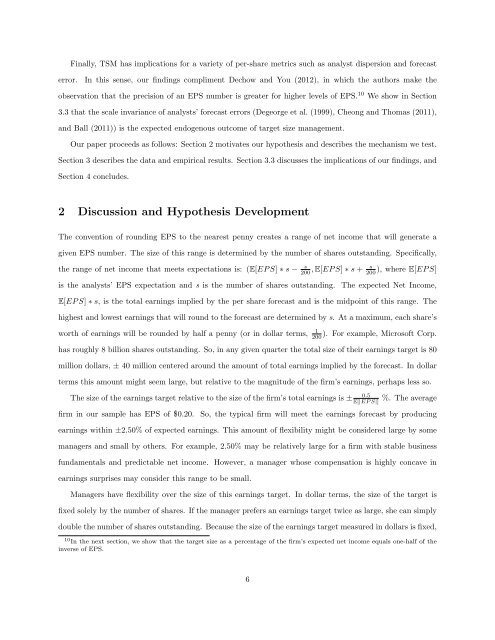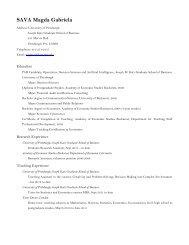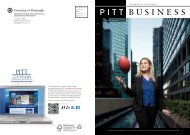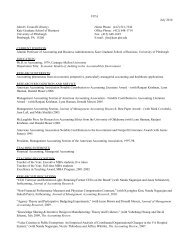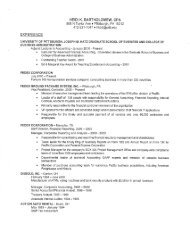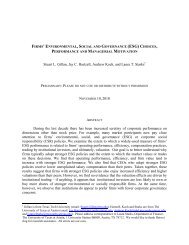Gaming the Float: How Managers Respond to EPS-based Incentives
Gaming the Float: How Managers Respond to EPS-based Incentives
Gaming the Float: How Managers Respond to EPS-based Incentives
Create successful ePaper yourself
Turn your PDF publications into a flip-book with our unique Google optimized e-Paper software.
Finally, TSM has implications for a variety of per-share metrics such as analyst dispersion and forecast<br />
error.<br />
In this sense, our findings compliment Dechow and You (2012), in which <strong>the</strong> authors make <strong>the</strong><br />
observation that <strong>the</strong> precision of an <strong>EPS</strong> number is greater for higher levels of <strong>EPS</strong>. 10 We show in Section<br />
3.3 that <strong>the</strong> scale invariance of analysts’ forecast errors (Degeorge et al. (1999), Cheong and Thomas (2011),<br />
and Ball (2011)) is <strong>the</strong> expected endogenous outcome of target size management.<br />
Our paper proceeds as follows: Section 2 motivates our hypo<strong>the</strong>sis and describes <strong>the</strong> mechanism we test.<br />
Section 3 describes <strong>the</strong> data and empirical results. Section 3.3 discusses <strong>the</strong> implications of our findings, and<br />
Section 4 concludes.<br />
2 Discussion and Hypo<strong>the</strong>sis Development<br />
The convention of rounding <strong>EPS</strong> <strong>to</strong> <strong>the</strong> nearest penny creates a range of net income that will generate a<br />
given <strong>EPS</strong> number. The size of this range is determined by <strong>the</strong> number of shares outstanding. Specifically,<br />
<strong>the</strong> range of net income that meets expectations is: (E[EP S] ∗ s −<br />
s<br />
s<br />
200<br />
, E[EP S] ∗ s +<br />
200<br />
), where E[EP S]<br />
is <strong>the</strong> analysts’ <strong>EPS</strong> expectation and s is <strong>the</strong> number of shares outstanding. The expected Net Income,<br />
E[EP S] ∗ s, is <strong>the</strong> <strong>to</strong>tal earnings implied by <strong>the</strong> per share forecast and is <strong>the</strong> midpoint of this range. The<br />
highest and lowest earnings that will round <strong>to</strong> <strong>the</strong> forecast are determined by s. At a maximum, each share’s<br />
1<br />
worth of earnings will be rounded by half a penny (or in dollar terms,<br />
200<br />
). For example, Microsoft Corp.<br />
has roughly 8 billion shares outstanding. So, in any given quarter <strong>the</strong> <strong>to</strong>tal size of <strong>the</strong>ir earnings target is 80<br />
million dollars, ± 40 million centered around <strong>the</strong> amount of <strong>to</strong>tal earnings implied by <strong>the</strong> forecast. In dollar<br />
terms this amount might seem large, but relative <strong>to</strong> <strong>the</strong> magnitude of <strong>the</strong> firm’s earnings, perhaps less so.<br />
The size of <strong>the</strong> earnings target relative <strong>to</strong> <strong>the</strong> size of <strong>the</strong> firm’s <strong>to</strong>tal earnings is ± 0.5<br />
E[|EP S|]<br />
%. The average<br />
firm in our sample has <strong>EPS</strong> of $0.20.<br />
So, <strong>the</strong> typical firm will meet <strong>the</strong> earnings forecast by producing<br />
earnings within ±2.50% of expected earnings. This amount of flexibility might be considered large by some<br />
managers and small by o<strong>the</strong>rs. For example, 2.50% may be relatively large for a firm with stable business<br />
fundamentals and predictable net income. <strong>How</strong>ever, a manager whose compensation is highly concave in<br />
earnings surprises may consider this range <strong>to</strong> be small.<br />
<strong>Managers</strong> have flexibility over <strong>the</strong> size of this earnings target. In dollar terms, <strong>the</strong> size of <strong>the</strong> target is<br />
fixed solely by <strong>the</strong> number of shares. If <strong>the</strong> manager prefers an earnings target twice as large, she can simply<br />
double <strong>the</strong> number of shares outstanding. Because <strong>the</strong> size of <strong>the</strong> earnings target measured in dollars is fixed,<br />
10 In <strong>the</strong> next section, we show that <strong>the</strong> target size as a percentage of <strong>the</strong> firm’s expected net income equals one-half of <strong>the</strong><br />
inverse of <strong>EPS</strong>.<br />
6


